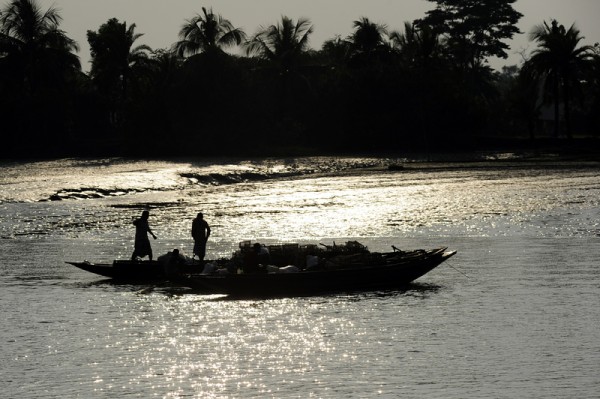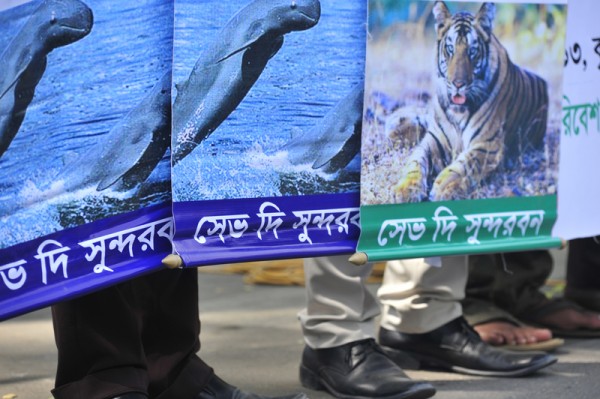A plan to erect a coal-fired power plant in Bangladesh next to the Sundarbans, the largest mangrove forest in the world which straddles Bangladesh and India, is drawing fire from activists in the country who say it would destroy the world heritage site.
The proposed 1320-megawatt plant, to be built in the area of Rampal in the southern Bagerhat district, was initially put into motion in a bilateral agreement between Bangladesh and India during the Bangladeshi prime minister's tour of India in 2011 before an environmental impact assessment was conducted by Bangladesh's Environment Ministry.
On 20 April, 2013, the Power Development Board of Bangladesh signed [bn] three agreements with India's National Thermal Power Corporation, which made the implementation official. The project, estimated to cost 1.6 billion US dollars, is expected to be completed by 2018.
When the government finally released an environmental impact assessment (download in PDF from here) on the power plant, environmentalists rejected it in a consultative meeting, organized by the Power Division on April 12, arguing that the report did not take into consideration most of the important environmental aspects of the Sundarbans, its ecology, flora, and fauna as well as a large number of local people.
Moreover, the report stated that (page 208) once the proposed site was a part of Sundarbans, but had been evacuated by the settlers later.
Bangladesh's energy infrastructure is known to be quite small, insufficient and poorly managed. Only 40% of the population has access to electricity with a per capita availability of 136 kWh per Annum. So there is a huge pressure on the Government to meet the growing demands of electricity.
The National Committee to Protect Oil, Gas, Mineral Resources, Power and Ports urged citizens of both India and Bangladesh to carry out concentrated efforts to stop the power plant on its website.
Abdullah Al Imran [bn] pointed out in a Facebook note that India is violating its own laws meant to protect wildlife with its involvement in this power plant:
On community blog Ishtishon, Mahbub Shumon questioned the wisdom of harming the Sundarbans when they protect Bangladesh from natural disasters:
Facebook events have been created to raise awareness of the planned plant. The dates of offline protests will be announced soon.
First Published in Global Voices
The proposed 1320-megawatt plant, to be built in the area of Rampal in the southern Bagerhat district, was initially put into motion in a bilateral agreement between Bangladesh and India during the Bangladeshi prime minister's tour of India in 2011 before an environmental impact assessment was conducted by Bangladesh's Environment Ministry.
On 20 April, 2013, the Power Development Board of Bangladesh signed [bn] three agreements with India's National Thermal Power Corporation, which made the implementation official. The project, estimated to cost 1.6 billion US dollars, is expected to be completed by 2018.
When the government finally released an environmental impact assessment (download in PDF from here) on the power plant, environmentalists rejected it in a consultative meeting, organized by the Power Division on April 12, arguing that the report did not take into consideration most of the important environmental aspects of the Sundarbans, its ecology, flora, and fauna as well as a large number of local people.
Moreover, the report stated that (page 208) once the proposed site was a part of Sundarbans, but had been evacuated by the settlers later.
Bangladesh's energy infrastructure is known to be quite small, insufficient and poorly managed. Only 40% of the population has access to electricity with a per capita availability of 136 kWh per Annum. So there is a huge pressure on the Government to meet the growing demands of electricity.
The National Committee to Protect Oil, Gas, Mineral Resources, Power and Ports urged citizens of both India and Bangladesh to carry out concentrated efforts to stop the power plant on its website.
Abdullah Al Imran [bn] pointed out in a Facebook note that India is violating its own laws meant to protect wildlife with its involvement in this power plant:
১৩২০ মেগাওয়াট ক্ষমতার একটা বিদ্যুতকেন্দ্র গড়ে উঠবে বাগেরহাটের রামপালে যা কিনা সুন্দরবন থেকে মাত্র ১৪ কিলোমিটার দূরে। ভারতের ওয়াইল্ড লাইফ প্রটেকশন এ্যাক্ট ১৯৭২ অনুযায়ী বাঘ-হাতি সংরক্ষণ অঞ্চল,জাতীয় উদ্যান এবং জীব বৈচিত্র্যের জন্য গুরূত্বপূর্ণ বনাঞ্চলের১৫ কিলোমিটার ব্যাসার্ধের মধ্যে কোন বিদ্যুৎকেন্দ্র তৈরী করা যায় না।
An 1320 MW plant would be established in Rampal of Bagerhat which is only 14 kilometres away from the Sundarbans. According to the Indian Wildlife Protection Act 1972, no such power plant should be established within 15 kilometers of a forest which is home to sanctuaries for tigers and elephants and wildlife.Journalist Kallol Mustafa [bn] summarized on Facebook the environmental impact that the report foresees that the plant will have:
বিদ্যুৎ কেন্দ্র নির্মাণের মালামাল ও যন্ত্রপাতি সুন্দরবনের ভেতর দিয়ে নদী পথে পরিবহন করা হবে। এর ফলে বাড়তি নৌযান চলাচল, তেল নি:সরণ, শব্দদূষণ, আলো, বর্জ্য নি:সরণ ইত্যাদি পরিবেশ আইন অনুসারে নিয়ন্ত্রণ না করা গেলে সুন্দরবনের ইকো সিস্টেম বিশেষ করে রয়েল বেঙ্গল টাইগার, হরিণ, ডলফিন, ম্যানগ্রোভ বন ইত্যাদির উপর ক্ষতিকর প্রভাব ফেলবে বলে ইআইএ রিপোর্টে আশংকা করা হয়েছে।
The building material and equipment for the plant would be transported on the river. So it is stated in the EIA report that the increase in transport of engine ships, oil spillage, noise, light and air pollution, etc. will have an adverse effect on Royal Bengal tigers, deer, dolphins, the mangrove forest and other ecosystems.Engineer Md. Shahadat Hossain [bn] wrote on the Water Resource Engineers Forum blog:
প্রস্তাবিত রামপাল কয়লা বিদ্যুৎ কেন্দ্রের ইআইএ রিপোর্টের এই সংক্ষিপ্ত পর্যালোচনা থেকে স্পষ্ট যে, [..] সুন্দরবনের পাশে ১৩২০ মেগাওয়াটের এই কয়লা বিদ্যুৎ কেন্দ্রকে জায়েজ করার সর্বোচ্চ চেষ্টা করা স্বত্ত্বেও, এরপরও খোদ ইআইএ রিপোর্টে বিদ্যুৎ কেন্দ্র নির্মাণ, পরিচালানা ও কয়লা পরিবহনের ফলে সুন্দরবনের উপর সম্ভাব্য ক্ষতিকর প্রভাব সম্পর্কে এমন সব তথ্য বেরিয়ে এসেছে যা প্রস্তাবিত কয়লা বিদ্যুৎ প্রকল্পকে পরিবেশগত বিবেচনায় অগ্রহণযোগ্য বিবেচনা করার জন্য যথেষ্ট।
Analysis of the EIA report for the proposed power plant reveals that the building, operation, and coal transport for the 1320 MW coal-based power plant in the Sundarbans would create an adverse effect on the Sundarbans mangrove forest in the coming years, suggesting that it should be scrapped on environmental grounds.
 |
| Fishermen prepare to fish before sunset near Karamjal Wildlife Breeding Centre in the East Sundarbans. Image by Firoz Ahmed. Copyright Demotix (26/11/2012) |
প্রথমত - ঝড় ঝাপটা প্রাকৃতিক দুর্যোগ থেকে থেকে বুক পেতে বাংলাদেশ রক্ষাকারী এই বনের মধ্যে বা কাছা কাছি ক্ষতিকর দূরত্বে এমন কোন প্রকল্প করা উচিৎ কিনা যা জীব - বইচিত্রের আধার এবং প্রাকৃতিক ভারসাম্য রক্ষাকারী, সর্বোপরি দুর্যোগ থেকে রক্ষাকারী এই প্রাকৃতিক দেয়াল ধ্বংস করে দিবে? সচেতন মানুষ মাত্রেই একমত হবেন নাবোধক উত্তরে। এমন বিদ্যুৎ আমাদের দরকার নাই যে বিদ্যুতের জন্য আমাদের দেশটাই ধ্বংস হয়ে যাবে। দ্বিতীয় জরুরী প্রশ্ন হল- অন্য কোথাও বিদ্যুৎ প্রকল্প করা হলেও আমরা কি কয়লা ভিত্তিক বিদ্যুৎ প্রকল্পের ক্ষতি সামাল দিতে পারব?
First of all, these mangrove forests save Bangladesh from natural disasters. So why would you put a project in the vicinity of this forest that will destroy its wildlife, its flora and fauna? Any concerned person would say no. We don't need such power which will destroy my country's ecosystem. Secondly, even if the plant is shifted, will we be able to restrict the damaging effects of burning coal for the plant?Blogger Banglar Hassan [bn] reminded his readers that a similar project had been turned down in Odisha, India as it failed to obtain environmental clearance. Faisal Caser [bn] asked:
যে বিবেচনায় এনটিপিসি নিজের দেশে বিদ্যুৎ কেন্দ্র নির্মাণ করতে পারেনি সেই একই বিবেচনায় বাংলাদেশে কী তাদের প্রকল্প বাতিল হতে পারে না?
The reason why NTPC could not build a power plant in its own country is not strong enough to stall their similar project in Bangladesh?
 |
| Facebook event to save Sundarbans. Image courtesy Omi Hasan. |
First Published in Global Voices

























0 comments:
Post a Comment